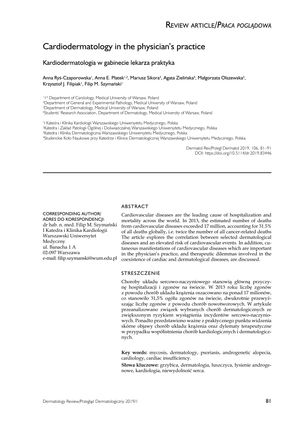Cardiodermatology in the Physician’s Practice
January 2019
in “
Przegla̧d dermatologiczny
”
psoriasis systemic sclerosis onychomycosis androgenic alopecia metabolic syndrome cardiac arrhythmias atherosclerosis myocardial ischemia peripheral artery disease hydrochlorothiazide photoprotection clubbed fingers severe early-onset androgenic alopecia nail fungus high blood pressure medication sun protection

TLDR Skin problems like psoriasis and systemic sclerosis can increase the risk of heart disease, so doctors should watch for heart risks in patients with these conditions.
The 2019 article discussed the connection between dermatological conditions like psoriasis, systemic sclerosis, and mycoses, and an increased risk of cardiovascular events. Psoriasis, which affects 2-4% of the population, shares a pathophysiological pathway with atherosclerosis and is associated with metabolic syndrome, potentially leading to cardiac arrhythmias. Systemic sclerosis contributes to 25% of patient deaths from cardiovascular causes due to accelerated atherosclerosis and myocardial ischemia. Onychomycosis, affecting up to 25% of the population, may signal atherosclerosis and is linked to an increased risk of peripheral artery disease. The article also covered drug interactions between antimycotic and cardiac medications, the photoallergic effects of cardiac drugs like hydrochlorothiazide, and the importance of photoprotection. Furthermore, it highlighted skin changes such as clubbed fingers and severe early-onset androgenic alopecia as indicators of cardiovascular disease. The conclusion emphasized the importance of monitoring cardiovascular risk in patients with dermatological conditions and the need for careful pharmacotherapy management. The authors declared no conflict of interest.



